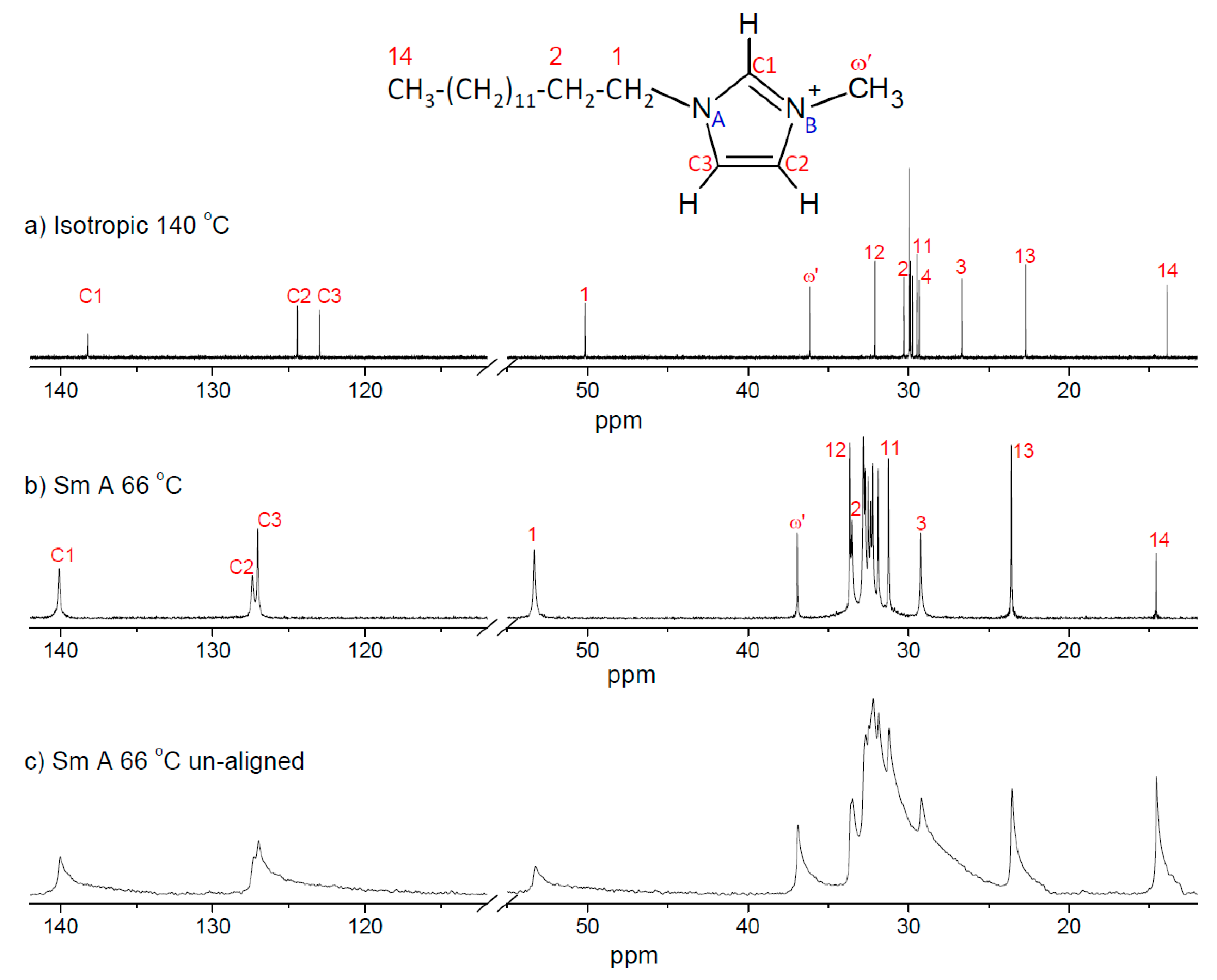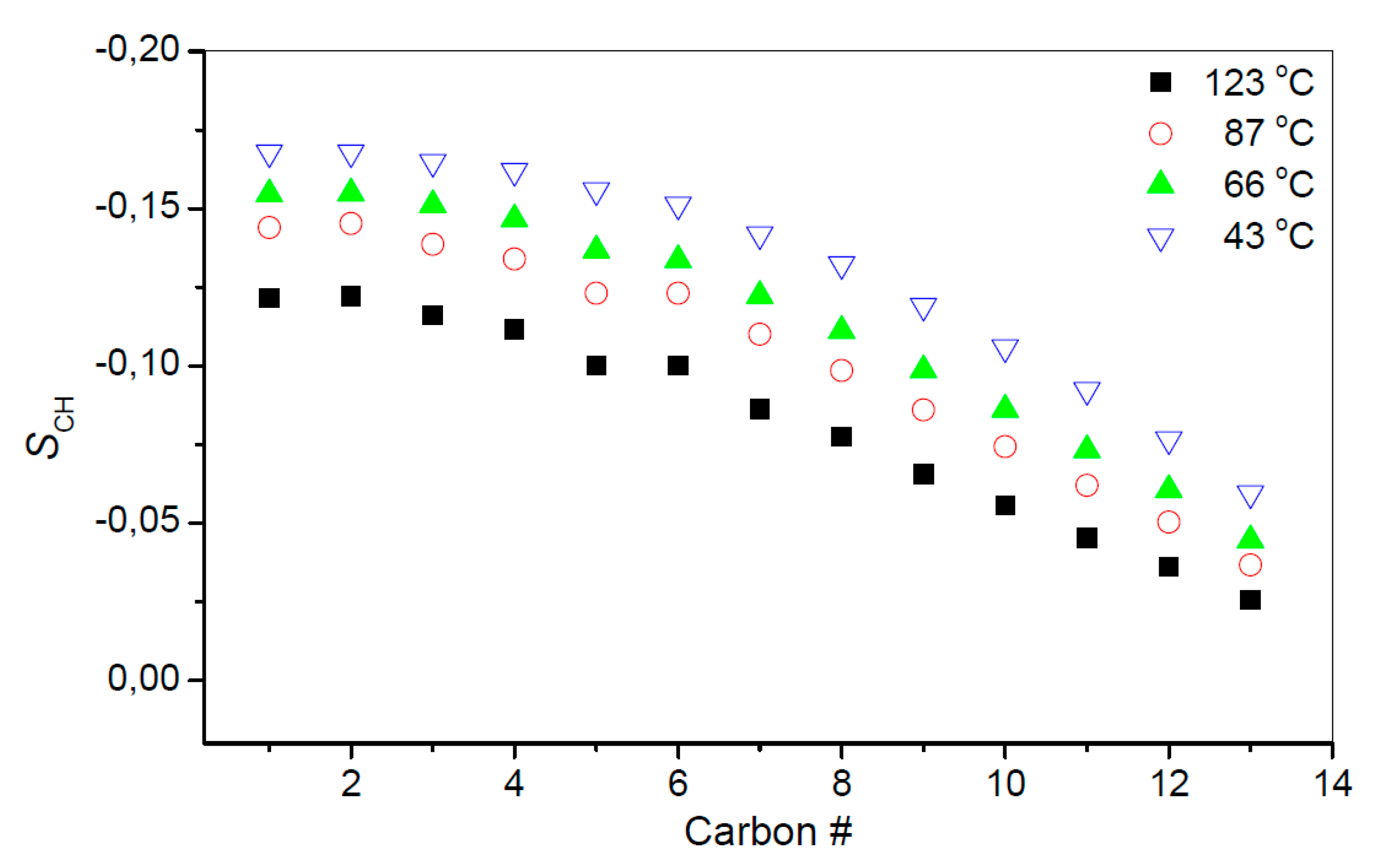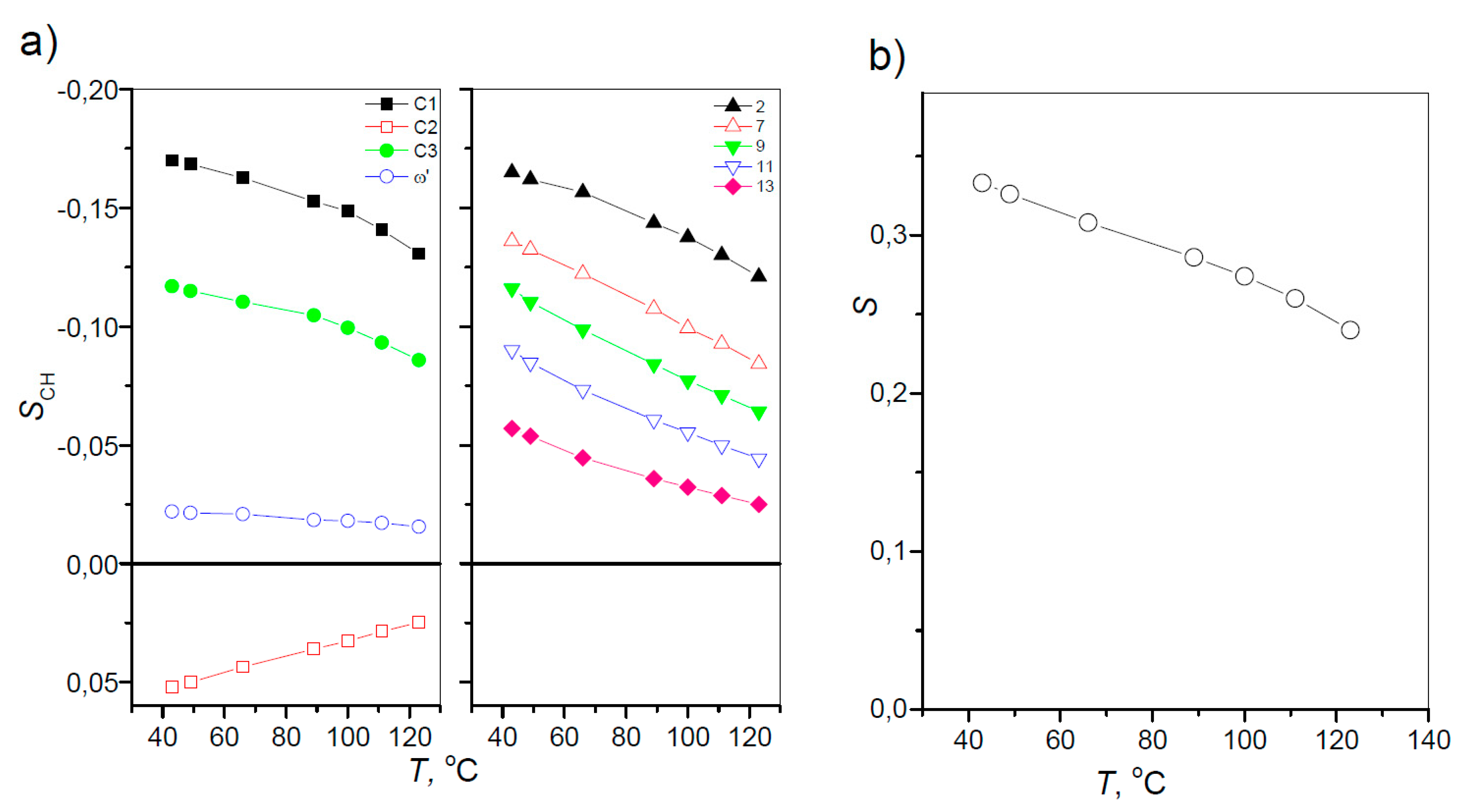Molecular and Segmental Orientational Order in a Smectic Mesophase of a Thermotropic Ionic Liquid Crystal
Abstract
:1. Introduction
2. Materials and Methods
3. Results and Discussion
3.1. Carbon-13 Nuclear Magnetic Resonance (NMR) Spectra
3.2. 1H–13C Dipolar Spectra
3.3. Order Parameters
4. Conclusions
Supplementary Materials
Author Contributions
Funding
Conflicts of Interest
References
- Goossens, K.; Lava, K.; Bielawski, C.W.; Binnemans, K. Ionic liquid crystals: Versatile materials. Chem. Rev. 2016, 116, 4643–4807. [Google Scholar] [CrossRef] [PubMed]
- Kato, T.; Yoshio, M.; Ichikawa, T.; Soberats, B.; Ohno, H.; Funahashi, M. Transport of ions and electrons in nanostructured liquid crystals. Nat. Rev. Mater. 2017, 2, 17001. [Google Scholar] [CrossRef]
- Dong, R.Y. Nuclear Magnetic Resonance Spectroscopy of Liquid Crystals; Worlds Scientific: London, UK, 2010. [Google Scholar]
- Dvinskikh, S.V.; Sandström, D.; Zimmermann, H.; Maliniak, A. Carbon-13 NMR Spectroscopy applied to columnar liquid crystals. Progr. Nucl. Magn. Reson. Spectrosc. 2006, 48, 85–107. [Google Scholar] [CrossRef]
- Dvinskikh, S.V. Characterization of Liquid-Crystalline Materials by Separated Local Field Methods. In Modern Methods in Solid-State NMR: A practitioners’ Guide; Hodgkinson, P., Ed.; Royal Society of Chemistry: Abingdon, UK, 2018. [Google Scholar]
- Boden, N.; Clark, L.D.; Bushby, R.J.; Emsley, J.W.; Luckhurst, G.R.; Stockley, C.P. A deuterium N.M.R. study of chain ordering in the liquid crystals 4,4′-di-n-heptyloxyazoxybenzene and 4-n-octyl-4′-cyanobiphenyl. Mol. Phys. 1981, 42, 565–594. [Google Scholar] [CrossRef]
- Dvinskikh, S.V.; Castro, V.; Sandström, D. Probing segmental order in lipid bilayers at variable hydration levels by amplitude- and phase-modulated cross-polarization NMR. Phys. Chem. Chem. Phys. 2005, 7, 3255–3257. [Google Scholar] [CrossRef] [PubMed]
- Kharkov, B.B.; Chizhik, V.I.; Dvinskikh, S.V. Low RF power high resolution 1H–13C–14N Separated local field spectroscopy in lyotropic mesophases. J. Magn. Reson. 2012, 223, 73–79. [Google Scholar] [CrossRef] [PubMed]
- Guillet, E.; Imbert, D.; Scopelliti, R.; Bunzli, J.C.G. Tuning the emission color of europium-containing ionic liquid-crystalline phases. Chem. Mater. 2004, 16, 4063–4070. [Google Scholar] [CrossRef]
- Fung, B.M.; Khitrin, A.K.; Ermolaev, K. An improved broadband decoupling sequence for liquid crystals and solids. J. Magn. Reson. 2000, 142, 97–101. [Google Scholar] [CrossRef]
- Lee, J.S.; Khitrin, A.K. Thermodynamics of adiabatic cross polarization. J. Chem. Phys. 2008, 128, 114504. [Google Scholar] [CrossRef]
- Dvinskikh, S.V.; Zimmermann, H.; Maliniak, A.; Sandström, D. Separated local field spectroscopy of columnar and nematic liquid crystals. J. Magn. Reson. 2003, 163, 46–55. [Google Scholar] [CrossRef]
- Burum, D.P.; Linder, M.; Ernst, R.R. Low-power multipulse line narrowing in solid-state NMR. J. Magn. Reson. 1981, 44, 173–188. [Google Scholar] [CrossRef]
- Berger, S.; Braun, S. 200 and More NMR Experiments: A Practical Course; Wiley: Leipzig, Germany, 2004. [Google Scholar]
- Dvinskikh, S.V.; Furó, I. Nuclear magnetic resonance studies of translational diffusion in thermotropic liquid crystals. Russ. Chem. Rev. 2006, 75, 497–506. [Google Scholar] [CrossRef]
- Fung, B.M. Liquid crystalline samples: Carbon-13 NMR. In Encyclopedia of Nuclear Magnetic Resonance; Grant, D.M., Harris, R.K., Eds.; Wiley: Chichester, UK, 1996; pp. 2744–2751. [Google Scholar]
- Dvinskikh, S.V.; Zimmermann, H.; Maliniak, A.; Sandström, D. Measurements of motionally averaged heteronuclear dipolar couplings in MAS NMR using R-type recoupling. J. Magn. Reson. 2004, 168, 194–201. [Google Scholar] [CrossRef] [PubMed]
- Dvinskikh, S.V.; Sandström, D. Frequency offset refocused PISEMA-type sequences. J. Magn. Reson. 2005, 175, 163–169. [Google Scholar] [CrossRef] [PubMed]
- Saielli, G. Fully Atomistic Simulations of the ionic liquid crystal [C(16)mim][NO3]: Orientational order parameters and voids distribution. J. Phys. Chem. B 2016, 120, 2569–2577. [Google Scholar] [CrossRef] [PubMed]
- Constant, M.; Decoster, D. Raman-scattering—Investigation of nematic and smectic ordering. J. Chem. Phys. 1982, 76, 1708–1711. [Google Scholar] [CrossRef]
- Fung, B.M.; Poon, C.-D.; Gangoda, M.; Enwall, E.L.; Diep, T.A.D.; Bui, C.V. Nematic and smectic ordering of 4-n-octyl-4′-cyanobiphenyl studied by carbon-13 NMR. Mol. Cryst. Liq. Cryst. 1986, 141, 267–277. [Google Scholar] [CrossRef]
- McMillan, W.L. Simple molecular model for the smectic A phase of liquid crystal. Phys. Rev. A 1971, 4, 1238–1246. [Google Scholar] [CrossRef]
- Ganzenmuller, G.C.; Patey, G.N. Charge ordering induces a smectic phase in oblate ionic liquid crystals. Phys. Rev. Lett. 2010, 105, 137801. [Google Scholar] [CrossRef]
- Gorkunov, M.V.; Osipov, M.A.; Kapernaum, N.; Nonnenmacher, D.; Giesselmann, F. Molecular theory of smectic ordering in liquid crystals with nanoscale segregation of different molecular fragments. Phys. Rev. E 2011, 84, 051704. [Google Scholar] [CrossRef]
- Klimavicius, V.; Gdaniec, Z.; Kausteklis, J.; Aleksa, V.; Aidas, K.; Balevicius, V. NMR and raman spectroscopy monitoring of proton/deuteron exchange in aqueous solutions of ionic liquids forming hydrogen bond: A role of anions, self-aggregation, and mesophase formation. J. Phys. Chem. B 2013, 117, 10211–10220. [Google Scholar] [CrossRef] [PubMed]
- Every, H.A.; Bishop, A.G.; MacFarlane, D.R.; Oradd, G.; Forsyth, M. Transport properties in a family of dialkylimidazolium ionic liquids. Phys. Chem. Chem. Phys. 2004, 6, 1758–1765. [Google Scholar] [CrossRef]
- Matveev, V.V.; Markelov, D.A.; Ievlev, A.V.; Brui, E.A.; Tyutyukin, K.V.; Lahderanta, E. Molecular mobility in several imidazolium-based ionic liquids according to data of H-1 and C-13 NMR relaxation. Magn. Reson. Chem. 2018, 56, 140–143. [Google Scholar] [CrossRef]
- Frise, A.E.; Dvinskikh, S.V.; Ohno, H.; Kato, T.; Furo, I. Ion channels and anisotropic ion mobility in a liquid-crystalline columnar phase as observed by multinuclear NMR diffusometry. J. Phys. Chem. B 2010, 114, 15477–15482. [Google Scholar] [CrossRef] [PubMed]
- Frise, A.E.; Ichikawa, T.; Yoshio, M.; Ohno, H.; Dvinskikh, S.V.; Kato, T.; Furo, I. Ion conductive behaviour in a confined nanostructure: NMR observation of self-diffusion in a liquid-crystalline bicontinuous cubic phase. Chem. Commun. 2010, 46, 728–730. [Google Scholar] [CrossRef]
- Cifelli, M.; Domenici, V.; Kharkov, B.B.; Dvinskikh, S.V. Study of translational diffusion anisotropy of ionic smectogens by NMR diffusometry. Mol. Cryst. Liq. Cryst. 2015, 614, 30–38. [Google Scholar] [CrossRef]
- Saielli, G. MD simulation of the mesomorphic behaviour of 1-hexadecyl-3-methylimidazolium nitrate: Assessment of the performance of a coarse-grained force field. Soft Matter 2012, 8, 10279–10287. [Google Scholar] [CrossRef]
- Saielli, G.; Voth, G.A.; Wang, Y.T. Diffusion mechanisms in smectic ionic liquid crystals: Insights from coarse-grained MD simulations. Soft Matter 2013, 9, 5716–5725. [Google Scholar] [CrossRef]




© 2018 by the authors. Licensee MDPI, Basel, Switzerland. This article is an open access article distributed under the terms and conditions of the Creative Commons Attribution (CC BY) license (http://creativecommons.org/licenses/by/4.0/).
Share and Cite
Dai, J.; Kharkov, B.B.; Dvinskikh, S.V. Molecular and Segmental Orientational Order in a Smectic Mesophase of a Thermotropic Ionic Liquid Crystal. Crystals 2019, 9, 18. https://doi.org/10.3390/cryst9010018
Dai J, Kharkov BB, Dvinskikh SV. Molecular and Segmental Orientational Order in a Smectic Mesophase of a Thermotropic Ionic Liquid Crystal. Crystals. 2019; 9(1):18. https://doi.org/10.3390/cryst9010018
Chicago/Turabian StyleDai, Jing, Boris B. Kharkov, and Sergey V. Dvinskikh. 2019. "Molecular and Segmental Orientational Order in a Smectic Mesophase of a Thermotropic Ionic Liquid Crystal" Crystals 9, no. 1: 18. https://doi.org/10.3390/cryst9010018
APA StyleDai, J., Kharkov, B. B., & Dvinskikh, S. V. (2019). Molecular and Segmental Orientational Order in a Smectic Mesophase of a Thermotropic Ionic Liquid Crystal. Crystals, 9(1), 18. https://doi.org/10.3390/cryst9010018




